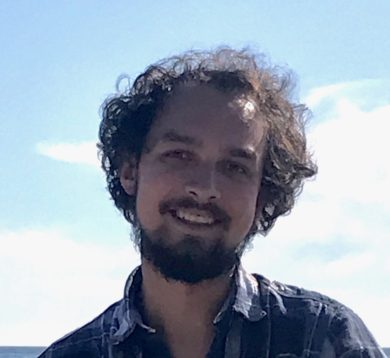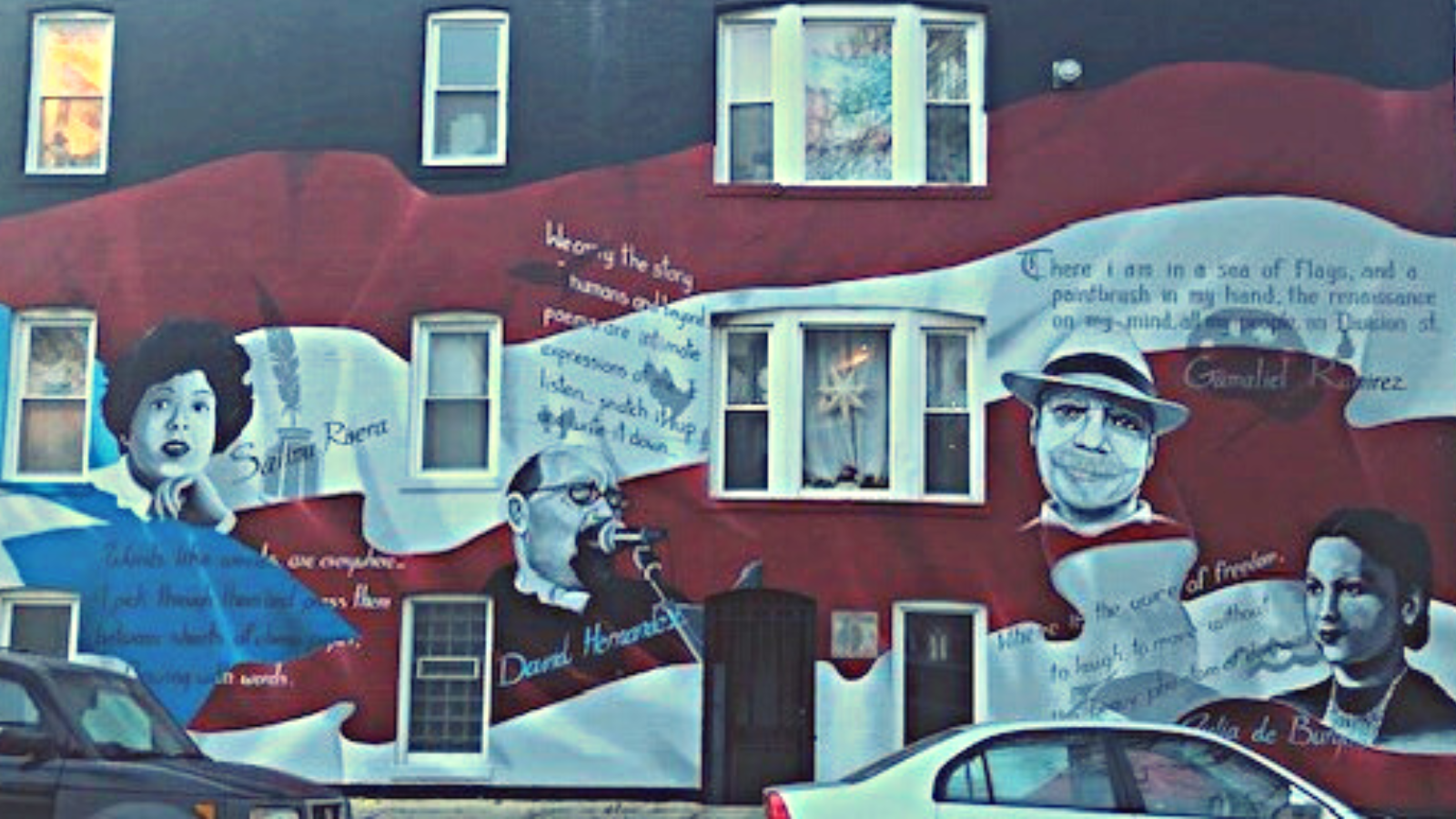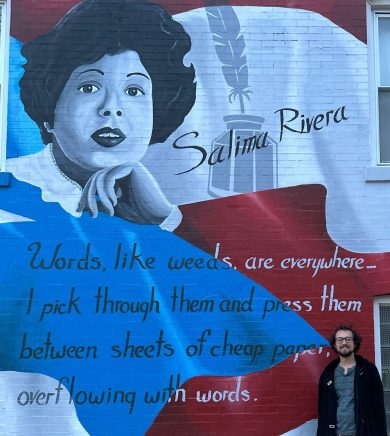 Joe Alicea is a PhD candidate in Literature at UC Santa Cruz. His dissertation focuses on the erasure of Chicago Puerto Rican poetry. Alicea served as a THI Summer Dissertation Fellow in Summer 2023 and was a part of THI’s Graduate Student Success Program. In October, we learned more about Alicea’s research work–particularly his interest in Chicago Rican artists as innovative practitioners of improvisation as a mode of upsetting dominant forms. We also discussed his recent field and archival research in Chicago, and the importance of structured peer mentorship programs for graduate student success.
Joe Alicea is a PhD candidate in Literature at UC Santa Cruz. His dissertation focuses on the erasure of Chicago Puerto Rican poetry. Alicea served as a THI Summer Dissertation Fellow in Summer 2023 and was a part of THI’s Graduate Student Success Program. In October, we learned more about Alicea’s research work–particularly his interest in Chicago Rican artists as innovative practitioners of improvisation as a mode of upsetting dominant forms. We also discussed his recent field and archival research in Chicago, and the importance of structured peer mentorship programs for graduate student success.
Hi Joe! Thank you for chatting with us about your ongoing work! To begin, would you provide us with an overview of your dissertation project and what you are currently focused on?
I understand Chicago Rican poetics as a range of lyrical, sonic, visual, and performative strategies born out of censorship. In my dissertation, I am sitting with/in that silence and listening for moments where “writing” and “rioting” converge.
My dissertation reflects on the erasure of Chicago Puerto Rican poetry. One of the first poems to focus on Chicago-based Puerto Ricans, a décima called “Los motines de Chicago” (1966), was written, performed, and recorded by Simón Gómez, a trovador from Puerto Rico. The décima celebrated the 1966 Division Street riots: three days of community struggle against the Chicago police that erupted just hours after Chicago’s inaugural Puerto Rican pride parade, when Chicago police officer Thomas Munyon shot Puerto Rican youth and northside local Arcelis Cruz. This poetic line of communication between Puerto Ricans from the archipelago to Puerto Ricans in Chicago was very quickly cut when the CIA decided to ban the record. I understand Chicago Rican poetics as a range of lyrical, sonic, visual, and performative strategies born out of censorship. In my dissertation, I am sitting with/in that silence and listening for moments where “writing” and “rioting” converge. I present close-readings and close-listenings of various Chicago Rican poets from the 1960s to the early 2000s and argue that, for these poets, writing/rioting is first and foremost an interactive and dangerous practice for rejecting forms and values imposed from above. While the CIA tried years ago to sever that line of communication, I maintain that the spirit of rioting endures in Chicago Rican writing, and that attending to this “spirit” can resurface ways of thinking about the self and community outside of the nation-state.
Currently, I am reluctant to describe my project as an attempt at “erasing erasure,” although it does look like that on its surface. The early Chicago Rican poets (many of whom were involved in the 1966 riots) were cautious about publishing their work, especially poems referencing the riots and other radical actions carried out by Puerto Ricans. It is also evident from poems, artist statements, and interviews that the early Chicago Rican poets were not interested in being recognized by and incorporated into the university, which they saw as an exclusionary institution holding a monopoly over the definition of poetry. By approaching erasure in Chicago Rican poetry as both violence and a strategy against violence and control, I hope to engage and mobilize theories and concepts developed by Chicago Rican poets to preserve the radical potential of their marginalization and “outsider status.”
In your dissertation, you focus partially on the instrumental improvisation of the Chicago Rican artist David Hernández. You’ve described improvisation as “an embodied, under-regulated, and open-ended form of communication” that has the capacity to “upset the dominant forms, values, and discourses of its social context.” Can you share more about your interest in this kind of multi-modal poetics as a mode of enduring and even escaping subjection?
I understand improvisation as the ecstatic discharging of the self or the “subject” towards the undefined and unregulated spaces between “self” and “other.”
David Hernández and Street Sounds blended music, poetry, dance, and visual art in their performances, enacting primarily the visual and aural sense modalities of their audiences. On one level, this multimodal poetics offers audiences multiple entry-points into the performance, and perhaps this expands the audience. When Hernández formed Street Sounds, he said his primary goal was to make poetry more widely accessible for a more heterogeneous audience. On another level, the enactment of multiple sense modalities allows audiences to let their eyes and ears wander and waver, to look and listen distractedly, as Licia Fiol-Matta has theorized in her book The Great Woman Singer. Building on Anthony Reed’s theorizations of improvisation and soundworks, I think multimodality helps facilitate a sort of “free play” of the senses enabling audiences to de- and re-compose what they are hearing/seeing/feeling without adherence to imposed standards or forms. In addition to “free play” and free or distracted listening/reading, improvisation is about losing the self. The Afro-Caribbean musical form of descarga, a mode of instrumental improvisation used in salsa, is a great example: it is an open-ended and ongoing practice that demands the improviser to discharge and unload (descargar). I understand improvisation as the ecstatic discharging of the self or the “subject” towards the undefined and unregulated spaces between “self” and “other.”
This Summer, you served as a THI Summer Dissertation Fellow, and conducted field research in Chicago. You had hoped to interview Chicago poets and rappers, scholars, publishers, and sound technicians and producers, as well as organize and digitizing materials belonging to poets David Hernández and Salima Rivera. Can you share a little bit about how the trip went and what you were able to accomplish?
Some things worked out and others didn’t. This was my first time doing field and archival research, and I had to improvise and occasionally redirect my attention to the unanticipated. Digitizing materials takes time, and I had to decide at a certain point that some of the materials I was digitizing, while valuable, were not necessarily helping with my research in an immediate sense. However, I came across a collection of old independently produced journals and university journals from the 1970s, and was able to preserve some amazing interviews, poems, and articles documenting the long history of collaboration between Puerto Rican artists, activists, and intellectuals in Chicago, New York City, Philadelphia, and the Puerto Rican archipelago. As far as digitizing some of the drafts, scores, and lesson plans of David Hernández, that is something I hope to return to on my next trip home to Chicago.
I imagine this trip revealed a host of interesting personalities and rich documents and stories, but was there an interview or a text, or even a specific moment that stands out to you from your time in Chicago that you’d like to share with us?

“Legends” mural, corner of West Pierce and St. Louis in Humboldt Park, Chicago, Illinois. Photograph by Joe Alicea.
There’s this mural called “Legends” at the corner of West Pierce and St. Louis in Humboldt Park featuring portraits of Chicago Rican poets David Hernández and Salima Rivera, Chicago Rican muralist Gamaliel Ramirez, and Puerto Rican poet Julia de Burgos. The owner of the building and one of the coordinators behind the mural project–a Chicago Rican artist, writer, activist, social worker, and bilingual educator by the name of Edmee Cappas Velez–was incredibly welcoming to me. Her home is like a museum, packed with art, documents, and history of Puerto Rican Chicago dating back to the 1960s. I had already gone to the Puerto Rican Cultural Museum and some of the cultural centers, but nothing compares. It was a reminder that much of the “lost” history of Chicago Rican literary and cultural production resides in the homes and memories of the locals who have maintained their place in Humboldt Park–the site of multiple riots–against the forces of privatization and gentrification in Chicago. They are very protective of this history and invested in how it is framed, and this has influenced my thinking on the ethics of claiming the authority to “erase erasure” or “fill gaps” from the privileged standpoint of an academic. Maybe some things need to stay secret to endure.
Who is one Chicago Rican artist you wish everyone knew about, and why?

Selfie of Joe Alicea next to a mural depiction of Salima Rivera.
Salima Rivera, also known as Sulima Quintana Moya. Her poetry feels like such a contradiction. It’s deep, contemplative, raw, erotic, full of rage and kindness.
Some poems are incredibly well-crafted, and others seem so spontaneous and unedited. As a political poet, she really walked the walk and was a very well-known activist and political figure under Harold Washington’s mayoral administration.
While she spent some time in mainstream politics, she never lost her edge and was a huge proponent for Puerto Rican freedom fighters. Her poems that reflect on violence, particularly violence as a means to liberation, are quite resonant today.
You were also a Fellow in THI’s Graduate Student Success Program. What, for you, was most fruitful about the program? Why is it important for graduate students to participate in structured peer mentorship programs like GSS?
I really didn’t know anything about the professional side of academia, and having a community to help guide me through that was definitely beneficial to me. I didn’t really know how to write a proposal for scholarships, fellowships, or grants, and I remember there being a THI+ event that was pretty much solely dedicated to that. I don’t think I would have had the opportunity to do this research if I wasn’t previously acquainted with that genre of writing.
Finally, can you share your favorite spot on UCSC’s campus?
I spend most of my time at McHenry Library and enjoy the sun rooms in the corner. Great for naps.
Banner Image: Paseo Boricua mural in Humboldt Park, Chicago. Photo by Joe Alicea.